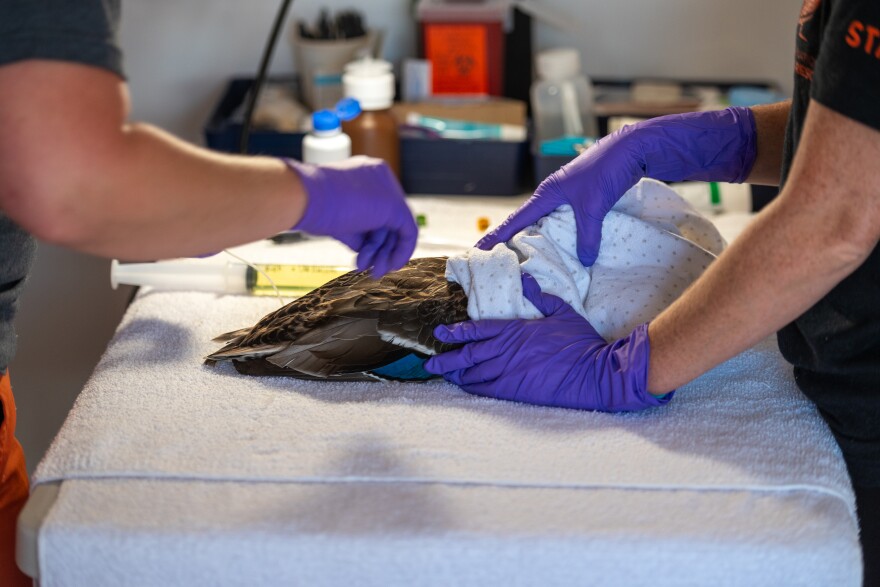TULARE LAKE – Just south of the shores of this ancient lake, Evan King brings 15 sick birds to a makeshift animal hospital at the Kern National Wildlife Refuge.
Veterinarians with University of California, Davis, have converted a home into a facility capable of treating hundreds of birds infected with a disease known as avian botulism.
Inside, veterinarians cradle tiny birds like infants, and feed them water and nutrients through small tubes in their beaks.
“It’s one of those things where it just has to work its way out. The treatment is providing them supportive care,” Jamie Sherman, a veterinarian with the Oiled Wildlife Care Network, said.
Already, Sherman and her team — which responds to animal emergencies across the state — have treated more than a thousand sick birds at the lake. Of those, they’ve been able to release nearly 700 back into the wild.

Disposing of dead birds and quarantining sick ones is the best tool rescue teams have to curb the botulism outbreak that has manifested in the waters of Tulare Lake, which refilled earlier this year for the first time in decades after a series of storms dumped massive amounts of rain and snow across California.
The water, slowly retreating, covers miles of former farmland and stretches as far as the eye can see.
Urban development, agriculture, and other factors have reduced wetlands in some areas of California by up to 90%. That means birds are crowded together, leaving them more susceptible to botulism and other disease outbreaks.
Making matters worse, North American bird populations have declined by more than a quarter since the 1970, according to Andrew Farnsworth, a researcher with the Cornell Lab of Ornithology. Those losses have taken a large toll on Central Valley species, in particular.
“The trends for [migrating birds in the Central Valley] are pretty alarming in terms of decline,” he says. “It’s something we really need to watch carefully.”
Preventing a mass die off


Botulism is a ruthless and efficient bird killer.
The toxin paralyzes birds from the bottom up, first robbing them of their ability to fly and eventually to breathe. The bacteria known as “clostridium” that causes avian botulism occurs naturally in the soil in the San Joaquin Valley, and thrives in the Valley’s scorching heat – and now the stagnant lakewater.
“It’s the perfect storm of conditions,” says King, a wildlife biologist with the California Department of Fish and Wildlife.
The fortunate news, he adds, is that the strain they are treating among birds is harmless to humans.
Altogether, King and his team have plucked nearly 3,000 birds from Tulare Lake since late August. They’re trying to prevent a mass die-off that could have a major impact on vulnerable migrating bird populations.
Their worries are hardly theoretical. The last time the lake refilled to significant levels in 1983, a botulism outbreak killed 30,000 birds.
That’s a significant number for migratory birds already facing the systematic destruction of their habitats, Farnswarth says.
“When you lose 30,000, or 40,000 in a particular place, that's a lot,” he says.
Central California is an important rest stop on the Pacific Flyway, a bird superhighway that stretches from Alaska to the tip of South America.
For birds using the flyway, Tulare Lake is a blessing and a curse.
This habitat could shelter millions of birds as they fly south or stop to nest and mate. But the threat of botulism looming beneath the water’s surface is a major threat, says Andrea Jones, director of bird conservation at Audubon California.
“These birds are coming off the tail end of their migration from Alaska, for instance. They’re hungry. And then they hit a disease outbreak and they’re at a stage where they’re incredibly vulnerable because they’ve just done this massive flight,” Jones says. “It’s important to get a handle on these outbreaks before … they have population-level impacts.”
Dangers persist
While infected birds can’t spread the toxin directly, their carcasses attract maggots which can supercharge outbreaks.


“The more carcasses you can remove from the water, the better you feel at the end of the day because you’re preventing the future loss of birds,” says King, the state wildlife biologist.
The rate of dead birds on the water has fallen in recent weeks, he adds – a sign their efforts are paying off.
And their hope is the threat of botulism will decline as the weather cools. But, still, rescuers fear an even larger outbreak next spring, especially if a forecasted El Niño dumps more water across the region.
Back on the lake, King revs the engine of an airboat and launches it from a crumbling agricultural levy. The boat whirs along the surface of the lake.
King is searching for more sick and dead birds.
A few minutes after taking off, he finds his first patient: A cinnamon teal duck.
Its head droops listlessly just above the water. “Inability to fly, flopping across the water like that,” he yells over the thrum of the airboat’s giant propeller.
He says those are the classic signs of a bird infected with botulism.


